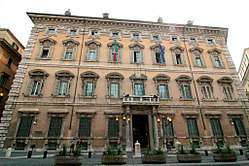Senate of the Kingdom of Italy
The Senate of the Kingdom of Italy (Italian: Senato del Regno d'Italia) was the upper house of the bicameral parliament of the Kingdom of Italy, established on 17 March 1861 upon Italian unification to replace the Subalpine Senate. It was suppressed on 7 November 1947 and replaced by the present-day Senate of the Republic. Its members were all appointed by the King of Italy.

History

The Senate of the Kingdom of Italy was created in 1861, following the Unification of Italy, as the direct successor of the Subalpine Senate of the Kingdom of Sardinia, with the addition of members drawn from the territories conquered during the Second Italian War of Independence and the Expedition of the Thousand.
The Senate was initially based at the Palazzo Madama in Turin, until 1864 when it was moved to the Palazzo Vecchio in Florence. Finally, in 1871, it was moved to the Palazzo Madama in Rome.
During the fascist regime, there was no "fascistisation" (fascistizzazione) of the Senate equivalent to that carried out in the lower house. Members of the Senate appointed before the March on Rome, such as Einaudi and Croce, retained their seats in the Senate. However, in 1939, when the lower house was transformed into the Chamber of Fasces and Corporations, 211 new members were added to the Senate.[1] When Fascism fell on 25 July 1943, King Victor Emmanuel III appointed Paolo Thaon di Revel as the President of the Senate - he entered office on 2 August 1943.
On 20 July 1944, Pietro Tomasi Della Torretta was appointed as the final President of the Senate, an office which he retained until 25 June 1946. In August 1944, all "Senators responsible for maintaining Fascism and enabling the war, through their votes and their individual actions, including propaganda carried out within or without the Senate" were dismissed from office.
Transformation into the Senate of the Republic
Following the Institutional Referendum of 2 June 1946 and the election of the Constituent Assembly of Italy, the Senate of the Kingdom ceased to function on 25 June 1946. It was formally suppressed on 7 November 1947,[2] thus bringing the Senate to extinction, although in fact it had lost almost all its limited power during the final years of the Fascist Regime. During the Fascist period, the Senate contained Fascist members, but because senators held office for life, it had remained somewhat outside Mussolini's state system and so, over time, it was pushed ever further towards the margins of political life.
The Senate of the Kingdom was the inspiration for the current Senate of the Republic, which came into existence on 8 May 1948.
The existence of the group of Senators for life in the modern Senate of the Republic represents a final survival of the life-long office of the Senators of the Kingdom of Italy.
Structure
The King appointed the Senators of the Kingdom ad vitam (for life). They were entitled to slightly higher honours than the elected deputies of the lower house. In time, although remaining formally a royal power, the appointment of senators came to be carried out largely on the recommendations of the Prime Minister, who was always in a position to influence the decisions of the king and to enhance support for the government in the Senate through the appointment of "batches" of Senators. Under Article 33 of the Albertine Statute, the number of Senators was not limited, but they had to be over forty years of age and drawn from one of the following categories:
- Archbishops and Bishops of the state;
- The President of the Chamber of Deputies;
- Members of the Chamber of Deputies who had served in three legislatures or for more than six years;
- Ministers of State;
- Undersecretaries of State;
- Ambassadors;
- Ministers Plenipotentiary, who had served for more than three years;
- First Presidents and Presidents of the Court of Cassation and the Court of Audit;
- First Presidents of the Court of Appeal;
- The Advocate General of the Court of Cassation, and the Prosecutor General, after they had served for five years;
- Presidents of the Class of Magistrates of the courts of appeal, who had served for more than three years;
- Members of the Court of Cassation and the Court of Audit, after 5 years
- Advocates general and fiscal, after 5 years
- General officers of land and sea, although major-generals and rear admirals had to have served for more than five years at that rank;
- Councillors of State who had served for more than five years;
- Division councillors who had served three terms as council president;
- Intendant generals who had served over seven years;
- Members of the Accademia nazionale delle scienze after seven years of membership;
- Ordinary members of the Higher Council for Public Education, after seven years in office
- Anyone who had glorified the nation through outstanding service or merit;
- Anyone who paid three thousand lira in import taxes over a period of three years on their own property or company.
Male members of the Royal family were members of the Senate by default and sat immediately behind the President of the Senate. They began to attend the Senate once they reached twenty-one years of age and were allowed to vote once they reached twenty-five.
Bibliography
- (in Italian) Francesco Bartolotta (ed), Parlamenti e governi d'Italia dal 1848 al 1970, Roma, Vito Bianco Ed., 1971.
References
- https://www.senato.it/1022
- "Legge costituzionale 3 novembre 1947, n. 3 - NORMATTIVA". www.normattiva.it. Retrieved 2016-04-19.